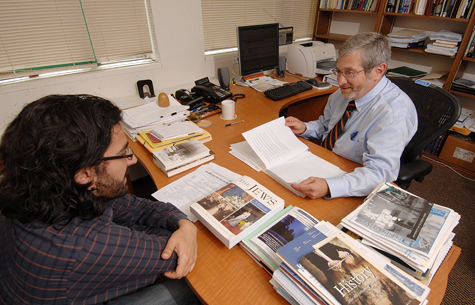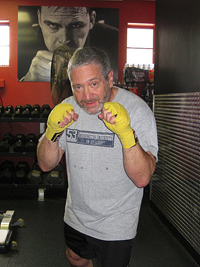
Joe Angeles
Hillel Kieval, PhD (right), the Gloria M. Goldstein Professor of Jewish History and Thought, meets with Jacob Labendz, graduate student in history in Arts & Sciences. Kieval’s wisdom and wit are well known around the WUSTL campus. Jean Allman, PhD, the J.H. Hexter Professor in the Humanities in Arts & Sciences, who succeeded Kieval as history department chair, says, “I often find myself, when faced with a tough decision or a difficult situation, thinking, ‘What would Hillel do?’ ”
They slaughter children to drink the blood of innocents. They’re weak — unsuitable for combat. Their men menstruate.
Myths like these have plagued the global Jewish population for hundreds of years. Examining how such prejudicial beliefs worked and how they shaped Jewish experience is a large part of the life’s work of historian Hillel Kieval.
Kieval, PhD, the Gloria M. Goldstein Professor of Jewish History and Thought in Arts & Sciences at Washington University in St. Louis, has spent the past 25 years studying European Jews in the 19th and 20th centuries.
His chief focus is the various ways in which they identified with, and struggled against, their European environment. Of particular interest are conflict, communication and miscommunication, and the ways in which social identity changes over time and under what conditions.
“In the end, I still remain fascinated by the persistence of what used to be called the ‘Jewish Question’ — what is to be done with the Jews? — which emerged together with the formation of modern states and struggles over Jewish emancipation,” Kieval says.
At the heart of that question lay the sense that the traditional, pre-modern status of Jews in European society, while perhaps deplorable, was at least understandable, given the laws and attitudes at the time. But as Jews were assimilated, the ground beneath began to shift.
“With the removal of legal barriers to integration and citizenship, nothing about Jews seemed certain any more,” Kieval says. “Who were they? What did they want? Where did their true loyalties lie?”
Early influences
After growing up in a conservative religious Boston-area household with a rabbi father, pursuing Jewish history as a career would seem like a natural step.
“It wasn’t exactly a big stretch for me,” Kieval says.
But it wasn’t an immediate choice, either.
Progressing through public school, Kieval had a hefty dose of supplementary Jewish education: 10 hours a week of Hebrew school in his elementary years and Hebrew-speaking overnight camps and classes at Hebrew College in high school.
His Hebrew immersion would serve him well in his research pursuits. Kieval also reads and speaks French, German, Czech and Hungarian in order to properly study Jewish communities in their European settings.
But as a freshman at Harvard University, Kieval imagined his adult life would focus not so much on sacred texts as psychoanalysis.
“I was most attracted to the idea of being a counselor or a clinical psychologist,” Kieval says. “I would say I’ve never given up my interest in psychology and psychological motivation as I look at cognition, memory, rationality and irrationality in Jewish history.”
‘What would Hillel do?’
After earning a bachelor’s degree in history and literature — French, German and modern Jewish — Kieval remained at Harvard to earn a master’s degree and then doctorate in modern Jewish and modern European history.
His next move took him from the East to the West Coast. Following a 13-year teaching career at the University of Washington, he settled in the heartland at WUSTL in 1998. Here, he has served both as director of Jewish, Islamic and Near Eastern Studies and as chair of the Department of History, both in Arts & Sciences.
Kieval’s wisdom and wit are well known around the WUSTL campus. Jean Allman, PhD, the J.H. Hexter Professor in the Humanities in Arts & Sciences and chair of the history department, says she’s filling some big shoes by succeeding him as department chair.
“Hillel was a brilliant leader for our department,” Allman says. “He steered a clear course, but in a quiet and unassuming way, and always with good humor. I often find myself, when faced with a tough decision or a difficult situation, thinking, ‘What would Hillel do?’”

Courtesy photo
Hillel Kieval recently took up boxing as a hobby. “So far,” he says, “I’m 1-0, and I think I might retire.”
Refuting ritual murder
For the past 10 years, much of Kieval’s research has focused on the subject of his upcoming book, Blood Inscriptions: The “Ritual Murder” Trial in Modern Europe, which he plans to finish in December 2010. Charges of ritual murder against Central and Eastern European Jews from the 1880s to the early 1900s have an air of the “revenge of the repressed.”
“The classical accusation in medieval Europe was that, periodically, Jews would kidnap and murder a prepubescent Christian boy in an imitation of the crucifixion of Jesus,” Kieval says.
According to the accusers, Jews used the blood to heal circumcision wounds, remove their “Jewish odor” or stop alleged male menstruation.
These modern cases and their high-profile trials are of particular interest to Kieval because they occurred after a hiatus of several centuries and alongside the development of modern science, forensics and legal procedure. The throat-slitting death of a 5-year-old boy in Prussia, for example, was twisted into a murder charge against a former Jewish butcher in a tangle of “investigation” and prejudice.
“A local non-Jewish butcher looks at the boy and says, ‘That is a kosher cut, the cut of a Jewish ritual slaughterer,’” Kieval says. “Then a physician looks at it and says, ‘Given the size of boy and the blood spatter in the vicinity, I don’t see enough blood present.’”
The implication that the missing blood was used for ritual purposes, along with the “expert” view of the wound, closed the case as far as the outraged non-Jewish community was concerned, even though, in this particular instance, the accused was acquitted.
From murder to manuscripts
Finishing the Ritual Murder book and a planned October trip to Hungary are taking Kieval away from teaching this fall. After that, classroom instruction will occupy about half his time, with the other half devoted to his next book, The Social Life of a Sacred Text: The Talmud and Jewish Identity in Modern Europe.

Courtesy photo
Hillel Kieval with his daughter.
It’s a project for which Kieval is uniquely qualified, according to Martin Jaffee, PhD, professor of Jewish studies at the University of Washington, with whom Kieval spent five years editing the AJS Review: The Journal of the Association for Jewish Studies and once had an adjoining office in Seattle.
“Hillel is one of the few contemporary historians of Jewish modernity who is deeply familiar with the classical literature of rabbinic culture from antiquity until early modern times,” Jaffee says. “We spent several years studying the Talmud together, and he really pressed me to defend my claim to ‘knowing something’ about the Talmud.”
Yet, in some ways, familiarity can hinder the study of one’s own people. Historians and students must detach themselves from the subject.
“If you don’t, then the tendency is to see every development as natural and obvious and maybe even necessary,” Kieval says. “You can’t begin to ask interesting questions of the past until you dismiss yourself from it, even if you happen to be Jewish and you’re studying Jews.”
Fast facts about Hillel Kieval
Family: Married to WUSTL librarian Deborah Katz; son, Michael, and daughter, Shira, both attorneys; and two granddaughters, aged 2½ years and 6 months.
Activity that clears his mind: Hiking, especially in Glacier National Park, Grand Teton National Park and the Canadian Rockies.
Most recent hobby: Boxing. He won his first sparring match: “So far,” he says, “I’m 1-0, and I think I might retire.”
Baseball loyalties: Kieval and his two brothers attend Cardinals’ spring training every year: “I really like the Red Sox, but I mainly hate the Yankees,” he says. “The Cardinals are my team right now.”